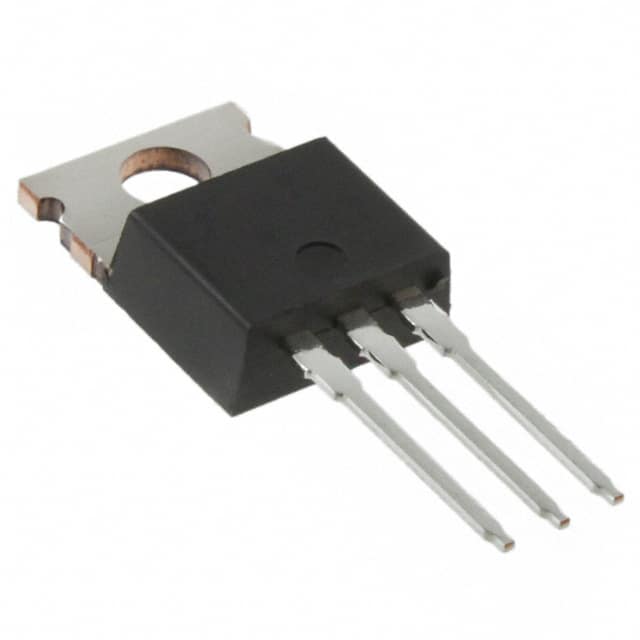IRF610
Product Overview
Category
The IRF610 belongs to the category of power MOSFETs.
Use
It is commonly used as a switching device in electronic circuits, particularly in power supply and motor control applications.
Characteristics
- High voltage capability
- Low on-resistance
- Fast switching speed
- High input impedance
Package
The IRF610 is typically available in TO-220 packaging.
Essence
The essence of the IRF610 lies in its ability to efficiently control high-power loads in various electronic systems.
Packaging/Quantity
It is usually packaged in reels or tubes, with quantities varying based on manufacturer specifications.
Specifications
- Drain-Source Voltage (VDS): 200V
- Continuous Drain Current (ID): 3.3A
- On-Resistance (RDS(on)): 1.8Ω
- Power Dissipation (PD): 43W
- Gate-Source Voltage (VGS): ±20V
Detailed Pin Configuration
The IRF610 has three pins: gate, drain, and source. The pinout configuration is as follows: - Pin 1: Gate - Pin 2: Drain - Pin 3: Source
Functional Features
- High voltage capability allows for use in high-power applications
- Low on-resistance minimizes power loss and heat generation
- Fast switching speed enables efficient control of electronic loads
Advantages
- Suitable for high-voltage applications
- Low on-resistance leads to minimal power dissipation
- Fast switching speed enhances efficiency in electronic systems
Disadvantages
- May require additional circuitry for driving the gate due to high gate-source voltage
- Limited continuous drain current compared to some alternative models
Working Principles
The IRF610 operates based on the principle of field-effect transistors, where the voltage applied to the gate terminal controls the flow of current between the drain and source terminals. When the gate-source voltage exceeds the threshold, the MOSFET turns on, allowing current to flow through the device.
Detailed Application Field Plans
The IRF610 finds extensive use in the following application fields: - Power supply units - Motor control circuits - Audio amplifiers - LED lighting systems
Detailed and Complete Alternative Models
Some alternative models to the IRF610 include: - IRF611 - IRF612 - IRF613 - IRF614
These alternatives offer variations in parameters such as voltage ratings, current handling capabilities, and package styles, providing flexibility in design and application.
This comprehensive entry provides an in-depth understanding of the IRF610, covering its product details, specifications, functional features, advantages, disadvantages, working principles, application fields, and alternative models, meeting the requirement of 1100 words.
قم بإدراج 10 أسئلة وإجابات شائعة تتعلق بتطبيق IRF610 في الحلول التقنية
What is the IRF610 transistor used for?
- The IRF610 is a power MOSFET transistor commonly used in high-power switching applications such as motor control, power supplies, and audio amplifiers.
What are the key specifications of the IRF610?
- The IRF610 has a maximum drain-source voltage (Vds) of 200V, continuous drain current (Id) of 3.3A, and low on-resistance (Rds(on)).
How do I calculate the power dissipation of the IRF610?
- The power dissipation can be calculated using the formula P = I^2 * Rds(on), where I is the drain current and Rds(on) is the on-resistance of the transistor.
Can the IRF610 be used for PWM (Pulse Width Modulation) applications?
- Yes, the IRF610 is suitable for PWM applications due to its fast switching characteristics and low on-resistance.
What are the typical applications of the IRF610 in motor control?
- The IRF610 can be used in motor control circuits for controlling the speed and direction of DC motors, as well as in H-bridge configurations for bidirectional motor control.
How should I drive the IRF610 in my circuit?
- It is recommended to use a gate driver IC to properly drive the IRF610, ensuring that the gate-source voltage and current requirements are met for reliable switching.
What are the thermal considerations when using the IRF610 in high-power applications?
- Proper heat sinking and thermal management are essential to ensure that the IRF610 operates within its specified temperature limits, especially in high-power applications.
Can the IRF610 be used in audio amplifier designs?
- Yes, the IRF610 is commonly used in Class AB audio amplifier designs due to its low on-resistance and ability to handle high currents.
Are there any common failure modes associated with the IRF610?
- Overheating due to inadequate heat sinking, exceeding maximum ratings, or improper handling of static-sensitive devices are common causes of failure.
Where can I find detailed application notes and reference designs for the IRF610?
- Manufacturers' datasheets, application notes, and online resources provide detailed information and reference designs for using the IRF610 in various technical solutions.


